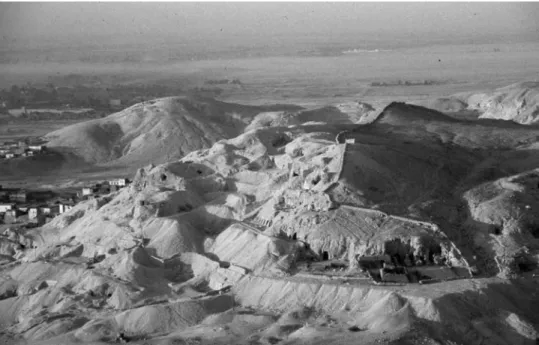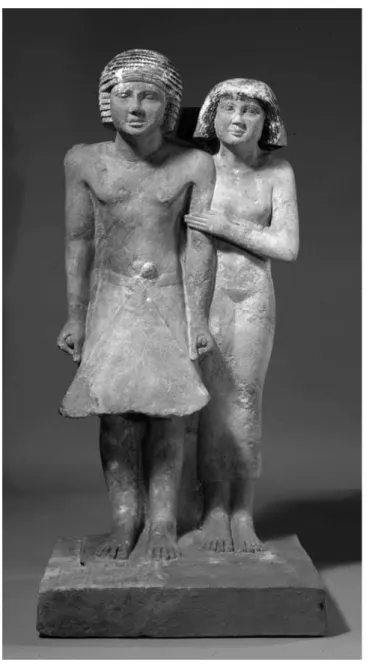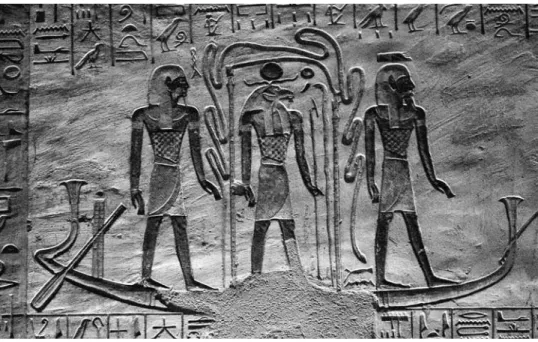Religion and the cult actions derived from those beliefs held ancient Egyptian society together and allowed it to flourish for more than three thousand years. This text does not start with the myths of Osiris and Isis or Horus and Seth, because there are many books that cover that well-trodden ground. Rather, my goal is to examine how the manifestations of religious beliefs were incorporated into the culture, how they formed the society, and what the impact of those complex beliefs and practices was on the people who lived in the Nile Valley thousands of years ago.
This book explores how the ancient Egyptians responded to their world. How did the Egyptian people relate to the great temples that dominated their cities? Did they even enter the temples? How did they regard and worship the gods? What was their attitude toward death, and how did they prepare for the end of life? What was the relationship between the realms of the living and the dead? How did religion color the most basic aspects of Egyptian life: birth, death, even commerce? These are among the questions investigated in the text that follows.
Whenever possible I have allowed the ancient Egyptians to speak for themselves by incorporating quotations from their letters, autobiographic texts, economic records, prayers, and inscriptions on tomb and temple walls. I have also brought paintings and reliefs, statues, and ritual objects
They [the Egyptians] are religious to excess, beyond any nation in the world.
– Herodotus This book is about how ancient Egyptians related to and worshipped their gods, and how religion affected their daily lives. It focuses on personal involvement with religion, and how religion and the human response to it – cult actions – formed the Egyptians’ material and psychological culture. The text explores what, in the most practical sense, their beliefs meant to the early Egyptians and how they incorporated religion into their lives. A study of Egyptian religious practice – of how religion permeated society and stim-ulated human action – must include an examination of what the people were like, how they conceived of their gods, and what they apparently (reading backward from their practices) “needed” from their religion, that is, how they approached their own beliefs and responded to those beliefs.
We are fortunate to have so many sources that describe both the impact of religion on individual Egyptians and how these individuals incorporated those beliefs into their day-to-day lives. Yet despite this wealth of sources, it is still frustratingly difficult to understand what these people, so removed from us by time, were really like. Did they cringe under the weight of the long tradition of their religion, the manifestations of which were omnipresent
1
The Egyptian Mind
the living Horus, the son of Osiris (Fig. 2). In some periods, if there were uncertainties about the succession, the king could be confirmed by divine oracle. There were few codified laws because the pharaoh was the highest judge in the land and all laws emanated from him. The dual props of the economy were land held by the temples and land held by the state, and there was often no clear division between the two.
Art and architecture were either outgrowths of religion or just its phys-ical manifestations. The record is skewed by the durability of stone tombs and temples compared to domestic structures of mud brick, but it is evi-dent that much architectural effort was devoted to structures that functioned in the context of religion. Art is a special case in ancient Egypt, for it was entirely intertwined with religion. Statues, paintings, and reliefs all served a religious purpose. Although the Egyptians certainly differentiated good art from bad, in their culture art was not created for its aesthetic value as it is in the Western tradition. To the Egyptians, a representation of an object was a counterimage – an actual substitute for the object portrayed. The statue of an individual, for example, had the potential to be imbued with the spirit of that person and to serve as his or her eternal double and surrogate. Statues were an essential part of mortuary cults because Egyptians believed that a per-son could not exist in the afterlife unless his or her image – in the form of a statue – was preserved among the living. The sculptures that now fill museum galleries, most of them carefully incised with the name of the deceased, were those eternal images that perpetuated the memory of the dead (Fig. 3). This was a practical and stunningly simple solution to immortality – as long as the individual was remembered on earth, that person had not died.
Writing too was a consequence of religion. The Egyptian language and its hieroglyphic script were referred to as medjet netcher, “words of the god.”
The Egyptian Mind
Writing was believed to have been given to humans by the god Thoth. Writing always had a religious potency, and to write about a thing or a person, or to read a reference to an individual, was to call that thing or person into existence. Thus a prayer written on a tomb wall asking that the deceased be provided with a thousand of bread, beer, oxen, and fowl actually made those foodstuffs eternally available (Plate I). And because the script was pictorial, the hieroglyphs, like statues, were replicas, or counter-images, of what they represented.
The institution of the priesthood was another aspect of religion that influenced daily life. As indicated by genealogies that noted peoples’ titles (at least for the elite for whom we have records), a large percentage of the population served in the temples or in funerary cults. The Egyptian tradi-tion of religious service was quite different from its Western counterpart. In the dynastic period, and indeed until the third century of our era, there was no monastic tradition and the clergy was not cloistered. On the con-trary, most Egyptian priests and priestesses lived in their own homes in their village or town and were free to marry and have families. The blurred
Figure 1. Aerial view of the necropolis in western Thebes (modern Luxor). The hillsides are dotted with the entrances to tombs. Many of the tombs would originally have had walled courtyards at their entrance (see lower right), making the necropolis look more like a village. Photo: Emily Teeter.
The Egyptian Mind
Figure 2. King Senwosert III of Dynasty 12. Kings were typically shown in an immobile and dignified manner. Here, the king is differentiated from his subjects by his striped headdress (nemes) and uraeus. His power is expressed by the bows of foreign enemies that he crushes under his feet and by the bull tail that hangs from his kilt (visible between his legs). Hierakonpolis. Brooklyn Museum 52.1 Charles Edwin Wilbour Fund.
The Egyptian Mind
Figure 3. Statue of Nenkhefetka and his wife, Nefershemes. The statue was deposited in the couple’s tomb, where it was to be an immortal reminder of them. Deshasheh Dynasty 5. OIM 2036a-b. Photo: Jean Grant. Courtesy of the Oriental Institute of the University of Chicago.
boundary between the clergy and the rest of the society is exemplified by the tradition of part-time priests (see further in Chapter 2), who practiced other professions when they were not on duty in the temple.
Using ancient texts and the archaeological record, this book explores how individuals functioned in ancient Egypt’s belief-saturated world. One might think that the ancient Egyptians were oppressed and culturally limited by the weight of religious thought and obligation. Yet although they
The Egyptian Mind
(they will “cut your purse”), and be obedient to your superiors. In addition, appearance and grooming were an important concern and investment for the ancient Egyptians. The status of Egyptian women was not all that dif-ferent from women’s status in parts of today’s world either. At least in legal affairs, women were considered to be the equals of men – although exercis-ing those rights socially was a more difficult matter; such legal equality has been achieved in only a handful of countries in the last half century.
The similarities between then and now are even more striking when the details of daily life are explored. Like us, the Egyptians had board games, tops, and other toys, and had collars for their pet dogs; they wrote romantic poetry; and parents wrote letters complaining about their children. We hear of adulterous couples, divorce, and money problems, and we see a familiar family structure (monogamous marriages and nuclear rather than extended families). The Egyptians expressed grief at funerals, and they named chil-dren after their parents or grandparents. All their routine trappings of life make the ancient Egyptians seem much more immediate, approachable, and appealing to us. Despite the millennia that have passed, what we know about Egyptian life is very recognizable.
It is also important, however, to be aware of the shortcomings of our documentation. The textual sources generally relate only what was socially desirable at the time. Thus the wisdom texts (written as models of proper behavior) give us the standards of ideal behavior. A more realistic picture can be gleaned from legal texts, from oracle texts, and even from informal notations on ostraca (usually more casual texts on bits of pottery or lime-stone) that tell us about community and family life and about social strife. In those sources, we get closer to hearing firsthand the people’s complaints and pleas, and, especially, how religion and belief affect them daily.
The Egyptian Mind
Indeed, there are so many aspects of ancient Egyptian culture that we recognize that it is tempting to assume that the Egyptians were very much like us, just separated from us by many thousands of years. But despite these similarities, it is unlikely that we would recognize ourselves, for Egyptians had an approach to understanding the world around them that was funda-mentally different from ours. The Egyptians were visually oriented and were tremendously keen observers of their environment. Their worldview was based entirely on concrete principles that they could see around them. One might characterize them as the most rational of people, for their response to their world was based on their observed reality. What may seem like odd rea-soning, obvious contradictions, or absurdities to us are only strange because our reality is different from theirs.1 Our reality is formed and informed by
a host of different scientific (and often seemingly irrational) ideas, whereas the Egyptians explained all natural phenomena in concrete terms, avoiding speculative thought. This is not to suggest that Egyptians were not crea-tive. On the contrary, their achievements in art and architecture, and the mythologies they created, all attest to incredibly fertile minds. But a major aspect of their psyche was that everything that was “unknowable” – the great mysteries of the prescientific age, such as why and how the sun crossed the heavens, and where the sun went when it set – could be explained in con-crete and familiar terms. To them, the sun crossed the sky in a boat because people in the Nile Valley traveled by boat. Or the sun was a great orb that was pushed across the sky by a scarab, an analogy based on observations of the natural world. They made no attempt to explain what the sky was, or what the sun was, or the relationship between the two elements.
This sort of reasoning also accounts for the way that the Egyptians regarded death. Faced with a seemingly unfathomable event, they articu-lated a vision of the hereafter modeled entirely on their own lives, down to the details of food, household effects, entertainment, and activities. The afterlife was a perfect mirror image of life because it avoided abstractions and the unknown. The Old Kingdom tomb, called the per djet, or “house of eternity,” physically resembled a house, complete with bedrooms; some even had bathrooms. The walls were covered with scenes that showed, and hence preserved and replicated, daily life activities and scenes of the natural world (Plate II). The unknowable was thereby made perfectly familiar, avoiding abstractions and uncertainty.
This reliance on observable and familiar patterns of daily life to explain the unknowable provided great comfort to the Egyptians. Everything was
The Egyptian Mind
related to recognizable life experiences. Conversely, to not know was fright-ening, and abstraction – the corruption of the natural world – was abhorrent to Egyptian thought.
The Egyptians’ reliance on physical explanations for natural processes was a fundamental and persistent feature of their culture. There was appar-ently no motivation for early thinkers to look beyond the physicality of the phenomenon. This was a “rational response to the intellectual and social context” of their time.2 As their society flourished and developed across three
thousand years, alternate explanations for physical phenomena were devel-oped. Yet new explanations did not displace old ones; for the Egyptians, a variety of explanations for a single phenomenon could simultaneously be held as true.3 What we might view as contradictions were in fact parts of
a series of complementary explanations that created a layered understand-ing. For example, consider the mythologies and religious texts that related how the sun was thought to cross the sky. In one version already noted,
Figure 4. The sun (Atum) in the form of a ram crowned with a sun disk crossing the underworld sky in a boat. The day sun was shown as a scarab, the night sun as the ram. Together they completed the cycle of dawn to dusk with the rebirth of the sun at dawn. Imitating human travel, the gods traveled by boat. Here Atum is protected by the coils of Mehen, a serpent, and flanked by Hw and Sia, the divine personifications of wisdom and creation. Tomb of Ramesses VI at Thebes. Dynasty 20. Photo: Emily Teeter.



